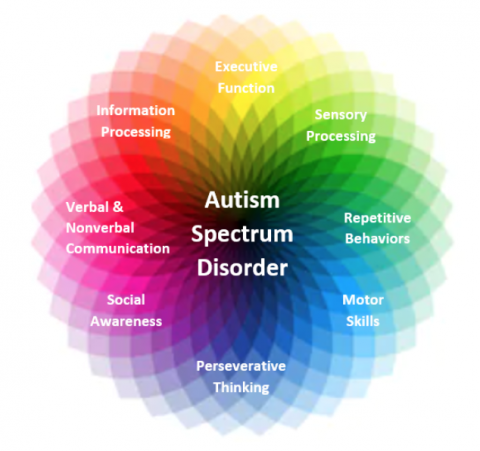Recognizing the Spectrum: A Comprehensive Guide to Autism Understanding
Recognizing the Spectrum: A Comprehensive Guide to Autism Understanding
Blog Article
Exploring Autism: Techniques for Efficient Interaction and Communication
Effective interaction and interaction with people on the autism spectrum necessitate a thorough understanding of their distinct demands and choices. The intricacies of these strategies expose further factors to consider that merit expedition, specifically in exactly how they can be adjusted to private experiences and varied contexts.
Comprehending Autism Range Disorder
Autism Range Disorder (ASD) includes a variety of neurodevelopmental problems characterized by difficulties in social interaction, interaction, and repetitive habits. The term "range" reflects the varied indications and varying degrees of seriousness experienced by individuals with ASD. While some might display significant problems, others may show high-functioning attributes, permitting for higher self-reliance in daily life.
The start of ASD generally occurs in early childhood years, with signs typically recognizable by age two. Early indicators may consist of delayed speech advancement, minimal eye contact, and problems in comprehending social signs. Although the accurate etiology of ASD stays vague, study recommends a combination of genetic and environmental variables plays an essential function in its advancement.
As a result, treatments and support customized to private needs are essential for cultivating interaction and social abilities. Recognizing the intricacy of ASD is crucial for promoting recognition, acceptance, and reliable techniques that help with purposeful interactions with people on the spectrum.

Value of Clear Interaction
Efficient communication is important for fostering understanding and link, especially for individuals with Autism Range Problem (ASD) Clear interaction not only facilitates social communications however likewise enhances the person's capability to express their needs, feelings, and thoughts. For people with ASD, the nuances of language can typically be challenging; consequently, utilizing straightforward and distinct language is crucial.
Additionally, clear communication aids decrease aggravation and anxiousness that may emerge from misconceptions. When messages are conveyed in a constant and straight manner, people with ASD are better furnished to interpret info properly, which can substantially boost their social interaction and engagement in various setups.
Establishing routines and making use of visual assistances can additionally bolster clear interaction. These strategies supply individuals with foreseeable structures that assist comprehension and retention of details. Additionally, actively being and listening patient throughout interactions promotes a helpful atmosphere where individuals with ASD feel valued and recognized.
Ultimately, prioritizing clear communication not just encourages people with ASD but likewise promotes even more purposeful links with their peers, caregivers, and the larger neighborhood, leading the means for comprehensive communications and collaborative relationships. - autism
Non-Verbal Interaction Strategies
Interaction expands past words, and for people with Autism Range Problem (ASD), non-verbal signs play a significant role in interactions. Non-verbal communication techniques can include faces, gestures, body movement, and eye call, every one of which function as essential parts for sharing feelings and purposes.
Recognizing and analyzing these non-verbal signals can boost communications with people with ASD. A cozy smile or open pose can develop a welcoming environment, encouraging engagement. Using aesthetic aids-- such as picture cards or icons-- can connect communication voids and assist convey messages more properly.
It is likewise important to be conscious of personal room, as people with ASD may have have a peek here various comfort levels regarding closeness. Observing their reactions to physical distance can notify suitable changes.

Developing Helpful Environments
Developing a helpful environment is crucial for cultivating positive interactions and boosting the well-being of people with Autism Spectrum Disorder (ASD) Such atmospheres can considerably reduce anxiousness and produce a feeling of security, permitting individuals to express themselves a lot more freely.
To attain this, it is vital to consider sensory level of sensitivities that individuals with ASD might experience. Modifying the physical area to include soft illumination, minimal background sound, and comfortable seats can create a soothing atmosphere. Furthermore, making use of constant regimens and clear visual timetables can help people anticipate shifts and lower uncertainty, additional advertising comfort.
Social areas should be structured to lessen frustrating stimuli while providing chances for involvement in preferred tasks. Helping with locations designated for peaceful time can additionally work as a sanctuary during minutes of stress. Significantly, including elements of selection empowers individuals, permitting them to work out agency in their environment.

Motivating Social Interactions
Promoting social communications among people with Autism Spectrum Problem (ASD) requires deliberate strategies that prioritize convenience and i was reading this engagement. Developing predictable routines can aid decrease anxiousness, making social settings much more friendly. Creating structured settings with defined obligations and duties allows individuals to involve without the frustrating pressure of unstructured social characteristics.
Including interests and staminas right into social tasks can function as a driver for communication. For instance, organizing group tasks around shared leisure activities or topics of fascination can assist in all-natural discussions and connections. Additionally, using visual assistances, such as social manuscripts or photographic timetables, can assist in understanding social cues and expectations.
Modeling appropriate social behaviors is critical - autism. Peers and grownups need to show reliable interaction strategies, consisting of energetic listening and turn-taking. Role-playing circumstances can additionally give a secure room for people to exercise these abilities
Finally, promoting peer connections with inclusive methods is vital. Motivating inclusive playdates or group trips can create opportunities for socialization in a comfy setup. By click reference applying these caregivers, strategies and instructors can dramatically boost social communications for individuals with ASD, promoting their total social advancement and well-being.
Verdict
In final thought, reliable interaction and interaction techniques are necessary for sustaining individuals with Autism Spectrum Condition. Eventually, these approaches encourage people with autism to navigate social landscapes, promoting their overall wellness and allowing the growth of long-term relationships.
Effective communication and interaction with individuals on the autism spectrum require a detailed understanding of their one-of-a-kind demands and choices. Clear interaction not just promotes social communications but also enhances the individual's ability to express their needs, thoughts, and feelings.Cultivating social communications among individuals with Autism Range Problem (ASD) calls for deliberate methods that prioritize comfort and engagement. By applying these caregivers, techniques and educators can considerably enhance social communications for individuals with ASD, advertising their general social development and health.
In verdict, effective interaction and communication strategies are essential for sustaining individuals with Autism Range Disorder.
Report this page